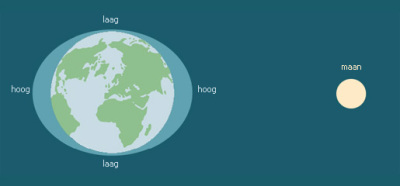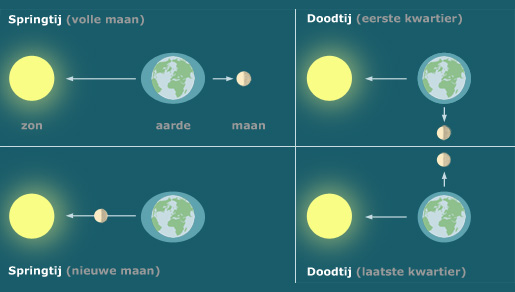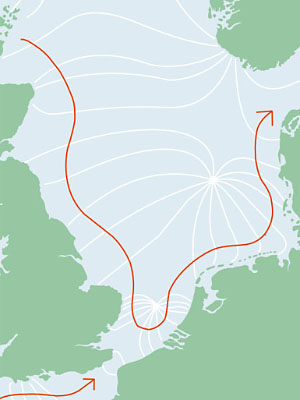Low and high tide
Ebb and flood are the tidal movements of the sea water. Ebb is when the water falls; so, ebb starts at high tide and lasts till low tide. Flood is when the water rises, from low tide to high tide. Ebb and flood are caused mainly by the gravitational force the moon exerts on the sea water. De tidal force arises because the gravitational force of the moon is not the same for every water particle on earth.

All water particles on earth are attracted by the moon. On the side of the earth that is closest to the moon, the water particles are attracted more strongly than on average. This causes a bulge of water on the side of the moon. On the other side of the earth the water particles are less attracted than on average. This also causes a water bulge, which faces away form the moon. So, there are two bulges of water on earth: the tidal bulges. Because the earth spins around its axis once every 24 hours, per day there are two high tides and two low tides. The earth moves beneath the tidal bulges, as it were.
Because the moon orbits the earth in about one month, during one day the moon also changes place a bit. That is the reason that high and low tide each day are about fifty minutes later than the day before.
Spring tide and neap tide
Not only the moon pulls on the sea water, the sun does this also. When sun and moon cooperate, it is spring tide. The tidal bulges are extra high; low tide is also extra low.
When sun and moon counteract each other, the tidal bulges are less high and low tide is less low. This is called neap tide.

At full moon and at new moon high tide is around 10 a.m. and 10 p.m. At first and last quarter high tide is around 3 a.m. and 3 p.m. During summertime, an hour must be added to these times.
Low tide is in between two high tides, but because the moon’s orbit is highly irregular, these times can vary with as much as an hour.

In the North Sea spring tide is two days after full moon and two days after new moon. This is when the tidal bulge from the southern Atlantic Ocean has arrived in our region. High water then is between 11 and 12 a.m. and p.m.
These times hold true for Schiermonnikoog, but not for other places along the North Sea coast. The tidal bulge enters the North Sea from the Atlantic Ocean between Scotland and Norway (and for a smaller part between France and England). In the North Sea it moves counterclockwise, so every place along the coast has separate times for ebb and flood.

